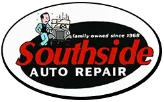WELCOME TO SOUTHSIDE AUTO REPAIR
BRAKE REPAIR IN LEXINGTON, KENTUCKY
Auto Brake Repair
It’s critical to maintain your brakes and the accessories that help them work with regular checkups and service. This helps ensure your safety while driving your vehicle so you can slow down and stop when needed. So, it’s important to know the signs to check for to determine whether or not your brakes need repair.
If your car begins making odd noises, pulls to one side, brakes lightly, or you experience a soft pedal, you should bring your car in to have the brakes checked. Our mechanics complete a free inspection that involves pulling off the wheels, looking at the brakes, and taking your car for a test drive before making a service recommendation.
If your car’s calipers are leaking, the pads are worn, or the rotors need to be turned, we accurately replace and repair the necessary parts to get you back on the road as quickly as possible.
